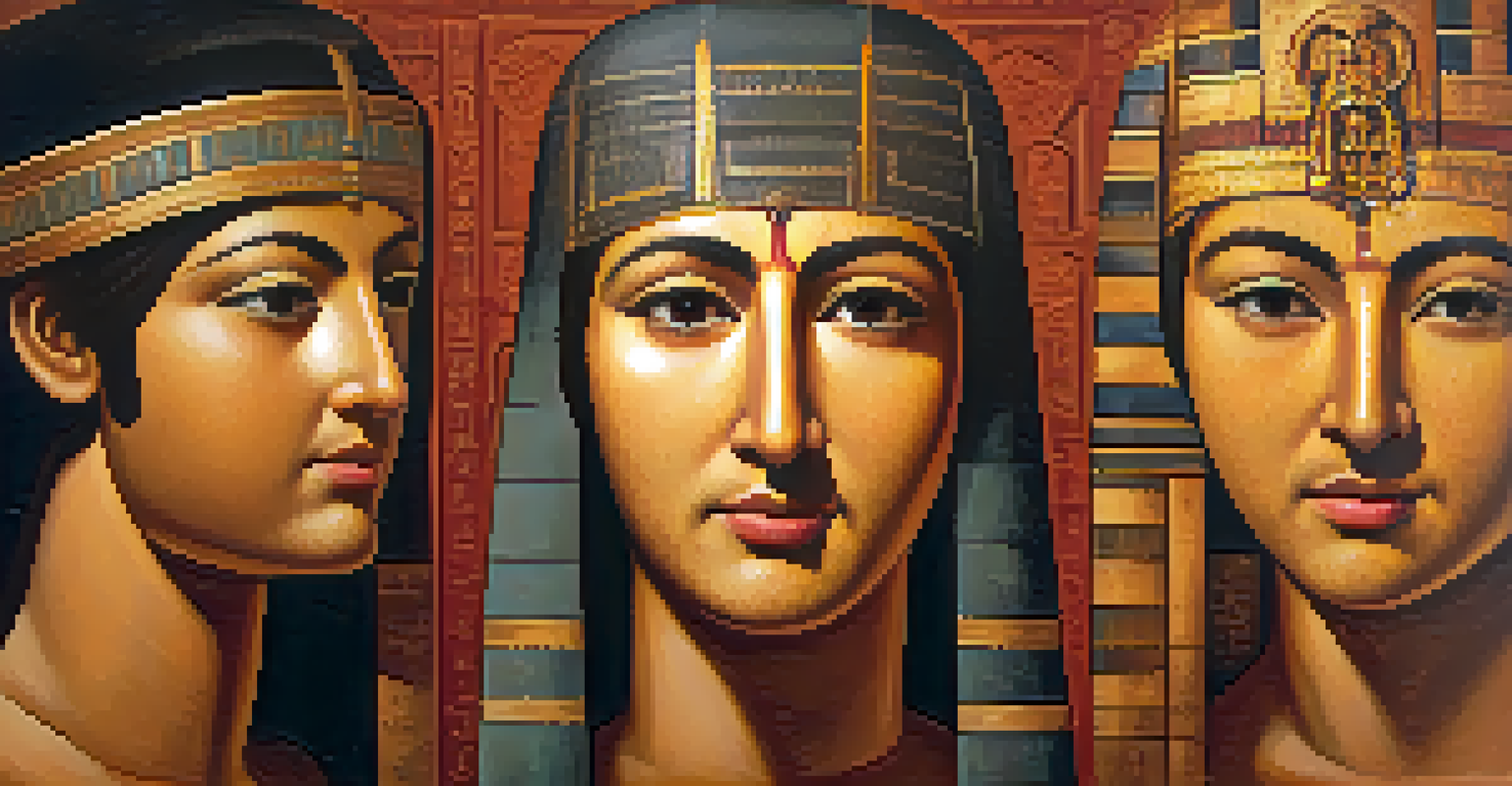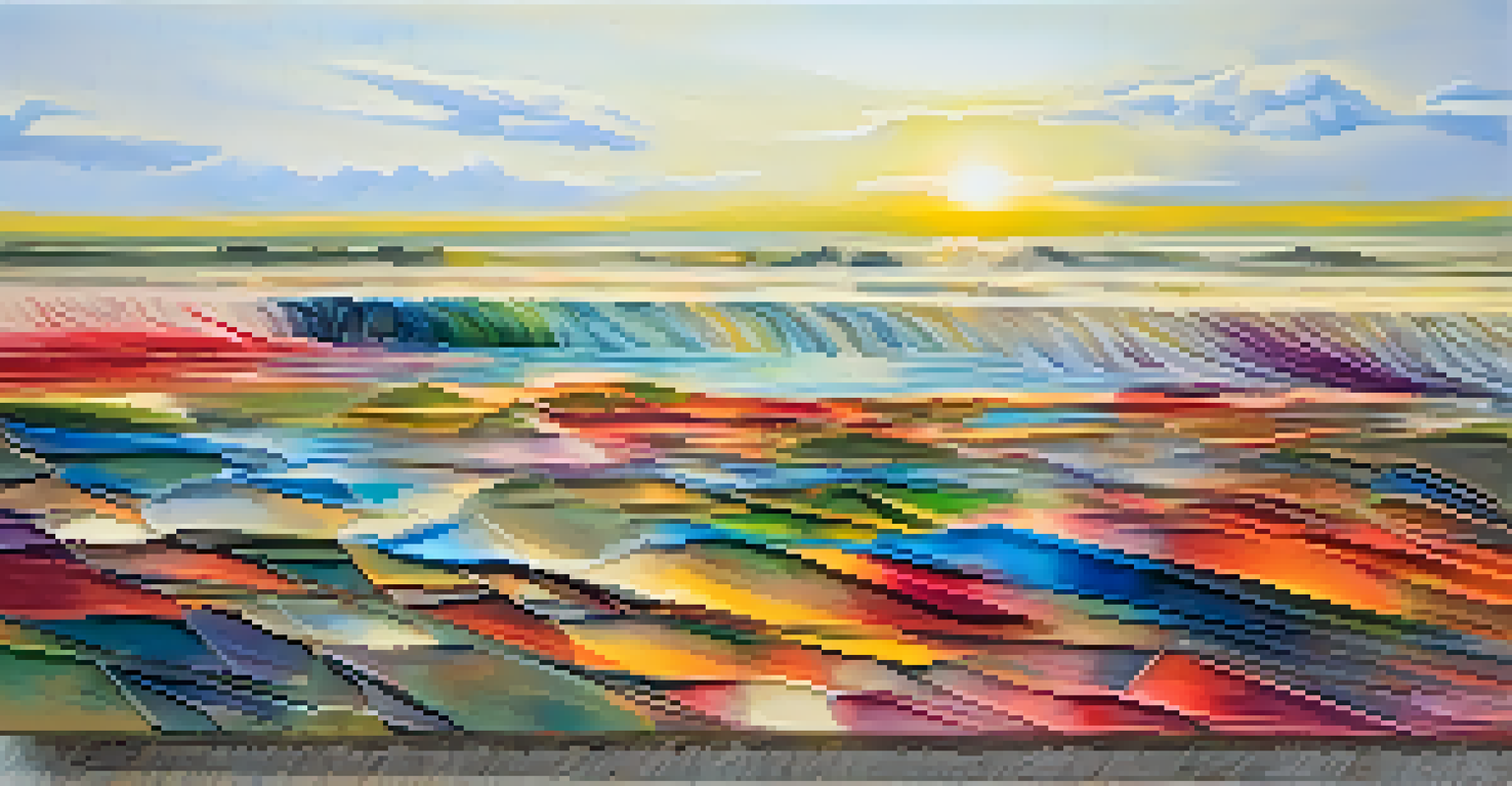The Role of Color in Historical Encaustic Painting

Understanding Encaustic Painting and Its Origins
Encaustic painting, a technique using heated beeswax mixed with colored pigments, dates back to ancient civilizations. The term 'encaustic' comes from the Greek word 'enkaustikos,' meaning 'to heat or burn in.' This method was notably used by the Greeks and Romans, who applied vibrant colors to create stunning works of art. By exploring its origins, we can appreciate how color played a pivotal role in expressing cultural narratives.
Color is the keyboard, the eyes are the harmonies, the soul is the piano with many strings.
The durability of the encaustic medium allowed artists to create vivid imagery that has withstood the test of time. This technique enabled a rich palette that could capture the subtleties of light and shadow, making the colors appear almost luminescent. For example, ancient Fayum portraits from Egypt showcase how color was used to convey realism and emotional depth, emphasizing the importance of color in artistic expression.
As we dive deeper into the history of encaustic painting, it's evident that the choices artists made regarding color were not just aesthetic. Each hue carried symbolic meanings, reflecting the values and beliefs of the time. This interplay between color and culture sets the stage for understanding the role of color in encaustic art.
The Role of Color Symbolism in Ancient Cultures
Color symbolism has been a powerful tool throughout history, providing deeper meaning to artistic works. In ancient Rome, red often symbolized power and sacrifice, while blue was associated with the divine. Artists intentionally selected colors to convey messages or evoke emotions, showing that color was more than just decoration; it was a language of its own.

In encaustic paintings, the use of specific colors could signify social status or religious beliefs. For instance, the use of gold and rich jewel tones often indicated wealth and prestige. This connection between color and societal values provides insight into how ancient artists used color to communicate their worldview, making their works resonate with viewers on multiple levels.
Encaustic's Rich Historical Roots
Encaustic painting, utilizing heated beeswax and pigments, has origins in ancient civilizations, highlighting the importance of color in cultural narratives.
By understanding the symbolism behind colors, we can appreciate how these choices shaped the narratives within encaustic paintings. The nuances of color not only enhanced the visual appeal but also served as a means of storytelling, allowing artists to connect with their audience in profound ways.
Color and Its Emotional Impact in Art
Color has a unique ability to evoke emotions, a trait that artists have skillfully utilized throughout history. In the context of encaustic painting, the interplay of warm and cool tones can create contrasting feelings. For example, warm colors like reds and yellows often evoke feelings of warmth and passion, while cooler hues such as blues and greens can inspire calmness and reflection.
Color is a power which directly influences the soul.
Artists like Jasper Johns and Robert Rauschenberg, who embraced encaustic techniques in the 20th century, manipulated color to provoke emotional responses. Their work often challenged viewers to reconsider their perceptions and feelings associated with color. This emotional aspect of color makes encaustic painting a dynamic medium, capable of resonating with audiences on a personal level.
By examining how color influences our emotions, we can better understand the power of encaustic paintings. Each brushstroke and hue selection becomes an invitation for the viewer to engage with the artwork, creating a dialogue between the artist's intention and the audience's experience.
The Evolution of Color Pigments Over Time
The palette available to encaustic painters has transformed dramatically over the centuries. In ancient times, artists relied on natural pigments derived from minerals, plants, and insects. These organic sources provided a limited color range, but their vibrancy and durability were significant, allowing for the creation of stunning works that have survived to this day.
With advancements in chemistry and technology, the 19th century saw a revolution in color pigments, introducing synthetic dyes and a broader spectrum of hues. This innovation allowed artists to experiment more freely with color, leading to exciting new styles and techniques in encaustic painting. Artists could now achieve colors that were previously unimaginable, expanding their creative possibilities.
Color Symbolism Shapes Art
Throughout history, artists have used color symbolism to convey deeper meanings and reflect societal values in their encaustic works.
The evolution of pigments not only influenced the aesthetic quality of encaustic works but also reflected the changing times. As new colors emerged, they often symbolized advancements in society and shifts in artistic movements, showcasing how the availability of color impacts artistic expression.
Techniques for Applying Color in Encaustic Painting
Encaustic painting involves unique techniques for applying color, making it distinct from other mediums. Artists typically layer wax and pigment, using tools like brushes and heated spatulas to manipulate the surface. This layering process allows for a rich depth of color and texture, creating a visually captivating experience for viewers.
One common technique is the use of 'fusing,' where heat is applied to melt the layers together, creating a seamless blend of colors. This method not only enhances the vibrancy of the hues but also adds a unique luminosity to the artwork. The dynamic nature of applying color in encaustic painting invites artists to experiment and discover new effects, pushing the boundaries of their creativity.
As artists explore these techniques, they often find that the unpredictability of encaustic can lead to serendipitous discoveries. The spontaneous interactions between colors and layers can result in unexpected visual outcomes, making each piece a unique expression of the artist's vision.
Cultural Influences on Color Choices in Encaustic Art
Cultural context plays a significant role in how color is perceived and used in encaustic painting. Different cultures have distinct associations with colors, which influence artists' choices. For example, in many Eastern cultures, white symbolizes purity and peace, while in Western contexts, it can represent emptiness or even mourning.
Artists often draw from their cultural heritage when selecting colors, ensuring that their works resonate with their audience. This cultural lens not only informs the palette but also shapes the thematic elements within the artwork. The blending of cultural influences can lead to innovative color combinations that enrich the narrative of the piece.
Modern Artists Redefine Color Use
Contemporary encaustic artists blend traditional techniques with modern themes, using color as a tool for storytelling and social commentary.
By examining the cultural influences on color choices, we can appreciate the diversity within encaustic art. Each artist brings their unique background and perspective, resulting in a vibrant tapestry of colors and meanings that reflect the richness of human experience.
Modern Interpretations of Color in Encaustic Painting
Today, contemporary artists are redefining the role of color in encaustic painting, blending traditional techniques with modern sensibilities. They explore themes of identity, memory, and social commentary, often using color to challenge perceptions and provoke thought. This evolution showcases how encaustic art remains relevant in today's artistic landscape.
Modern encaustic artists often experiment with mixed media, incorporating materials like photographs, paper, and textiles into their works. This fusion allows for a diverse palette and innovative approaches to color application, creating multi-dimensional pieces that engage viewers on multiple levels. Color becomes a tool for storytelling, enhancing the narrative and emotional depth of each artwork.

As we look at contemporary encaustic works, it's clear that color continues to play a vital role in shaping artistic expression. The ongoing exploration of color not only honors the rich history of encaustic painting but also propels it into new realms of creativity and interpretation.